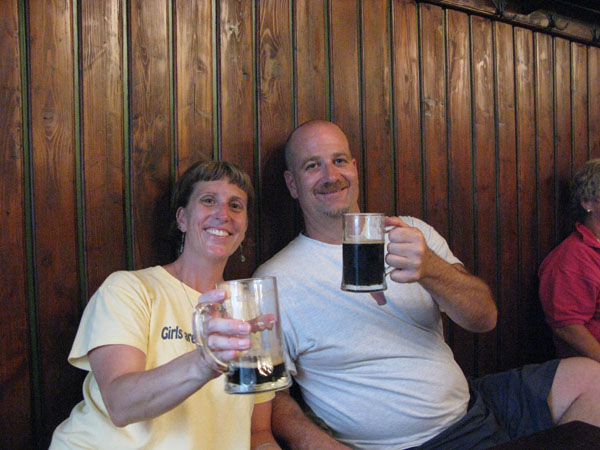On our little taxi excursion from the train station, our tour guide driver on several occasions gestured in the general direction of the Charles Bridge and Prague Castle. In his Czecho-Germano-English language, he indicated that’s where all the tourists were. Merideth and I smiled and nodded knowingly. We would tackle that beast the next day.

The plan for our second day in Prague was to cross the Vlata River to search out beer in the Malá Strana (Lesser Town). As our taxi driver had indicated, this part of Prague is the epicenter of the city’s tourist trade. Crossing the Charles Bridge late morning, we successfully negotiated the sea of globe trotters blindly following a person holding up an umbrella. Once across, we oriented ourselves and headed uphill in the direction of Strahov Monastery.

In the heat and humidity, I knew we weren’t going to make it in one shot. Consulting the Good Beer Guide, I found a pub roughly halfway to the monastery where we could get a break from the sauna-like weather and grab a beer. Our sanctuary was Baráčnická rychta, located on a side lane close the the Irish, German and American embassies.
Whether we were too far off the tourist trail or late-morning drinking is not fashionable, but we were the only customers. Passing on Pilsner Urquell, we both ordered a Svijanský Máz 11°, a beer from Liberec region of the Czech Republic. Beer had never tasted so good as the first sip of that golden brew.
In our second attempt at bonding with the locals by trying to learn the language, we asked our waiter how to pronounce the name of the pub. Where our waiter on the first day was more standoffish in giving Czech language lessons, today’s waiter was more helpful if not a bit confused. Unfortunately, we still don’t know how to correctly pronounce Baráčnická.

Strengthened with a few beers, we continued our upwards journey to the monastery. Founded in 1142, brewing began at the Strahov Monastery in the 13th or 14th century and lasted until 1907. The complex was renovated in the 1990s and a brewpub, Klášterní Pivovar Strahov, opened in 2000.
Entering the gates, we were greeted with the sounds of an orchestra performing in the courtyard between the church and brewpub. The brewpub was doing a brisk lunchtime business but we managed to grab a table outside where we could still hear the music.

There were four beers, a wheat, amber, dark and somewhat surprising, an IPA. While Merideth started with the wheat, I had to have a Czech IPA. Really fruity, the IPA was more of a hopped-up amber than what my jaded West Coast palate considers an IPA. I still liked it. The wheat was somewhat a cross between a Hefeweizen and Kristallweizen. A bit thin and lightly carbonated, it still had pleasant hefe flavor.
Merideth also had her first and probably only experience with Czech beer cheese. Hoping for an obaztda like experience, the beer cheese looked, smelled and tasted very gamey.

Heading back downhill towards the castle, we managed to hit a few more pubs before we reached Charles Bridge.
The unpasteurized Pilsner Urquell wasn’t the draw for stopping in U Hrocha. It was just the icing on the cake. It was the picture of the cute hippopotamus sign balancing a beer on the end of it’s nose in the Good Beer Guide that had us wandering the neighborhood around the British Embassy. As we spotted the sign hanging over the pub entrance, I felt somewhat silly being so excited at seeing a metal hippopotamus.
There were only a few locals ‘At the Hippopotamus’. As we enjoyed our Pilsner Urquell, we played ‘spot all the hippos in the pub’.

Our final pub in the Malá Strana was U Kocoura. Three breweries were featured at this pub, including the well-known Budvar and Pilsner Urquell. The beer we stopped for was Bernard’s kvasnicové pivo, apparently a rarely seen brew in Prague.
The kvasnicové pivo was really good but after so many different golden lagers, it was becoming difficult telling one from another. On top of that, every single beer was a magical moment; the cool, golden brew offering welcome relief from the heat.
Unfortunately, our day didn’t end on a high note. We went to a brewpub for dinner. Service in Prague has a reputation for snarkiness towards tourists, something I really have no problem with. But our waitress at dinner crossed the snarky line into just plain rudeness. Prague is a city every beer geek needs to experience. But our treatment at the brewpub led us to decide that this was most likely our last trip to Czech capital. Two visits was enough for these beer travelers. With so many great beer destinations throughout the world, Merideth and I would rather go someplace with more a chance not being treated like shit.

Thankfully, we had one more day in Prague so our last memory wasn’t of this brewpub. Day three was more of a day of relaxation than tramp around the city in search of beer. We had a nice lunch with Evan Rail, author of the Good Beer Guide. And we returned to U Fleků our final evening to get that much needed video footage. Amongst a bunch of Germans and Spaniards, we had a fun evening drinking beer and acting like goofy tourists. And, yet again, successfully turning down the shots of Becherovka.



























